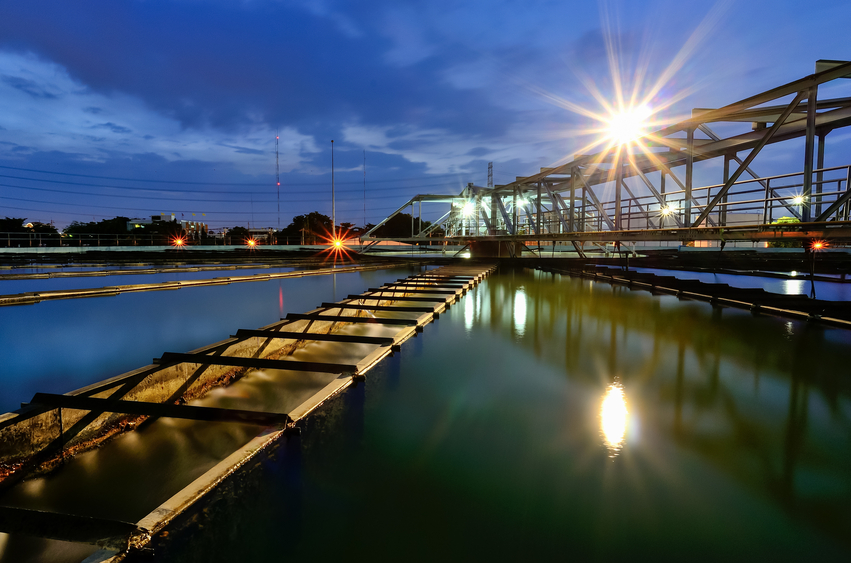Wastewater Engineering 24 PDH Discount Package 1
Courses in this Package
An Introduction to Control and Chemical Feeding for Wastewater Treatment (C02-051)
Package Plants for Wastewater Treatment (C01-008)
Using Combined Heat and Power at Wastewater Treatment Facilities (R04-007)
Wastewater Treatment Processes and Systems (C07-002)
Wastewater Treatment System Performance Requirements (C08-003)
Wastewater Treatment System Selection (C02-009)

This online engineering PDH course presents criteria on metering, instrumentation, controls, and chemical feeding devices used in wastewater disposal systems. Specific design problems may require departures from these practices; therefore, use these criteria with discretion.
For example, use of computers and microprocessors for data logging, indication, and process control is considered an emerging technology. This technology is presently primarily applicable to large wastewater treatment plants with adequately trained staff to maintain the hardware (greater than 10 Mgd size). However, improvements in electronics, hardware, software, and sensing devices (primarily sensing elements) will make this technology more desirable for smaller plants. Detailed information is not included for such emerging technology because of its state of rapid change and because additional development and application experience need to occur before application to the smaller facilities is justified.
This 2 PDH online course is intended for engineers and other design and construction professionals seeking an introduction to the process technologies, equipment and design practices for controlling and chemically treating industrial and oily wastewater.
This PE continuing education course is intended to provide you with the following specific knowledge and skills:
- Learning about primary measuring devices for wastewater treatment systems
- Learning about discrete and analog control devices and where they are applied
- Understanding the application and limitations of mechanical, pneumatic and electrical signaling systems
- Learning about the different chemical treatments for industrial wastewater streams containing cyanide, metals and oil
- Learning about the different types of chemical feeders and their application and limitations
- Knowing the basics of chemical treatment processes including adsorption, coagulation, oxidization, pH adjustment, precipitation and reduction
- Learning about the basics of metering, instrumentation, and control requirements for industrial wastewater treatment systems
- Learning about chemical handling and feeding systems and operations
- Understanding the function of different chemicals for industrial and oily wastewater treatment
In this professional engineering CEU course, you need to review the course document titled, "An Introduction to Control and Chemical Feeding for Wastewater Treatment".
Upon successful completion of the quiz, print your Certificate of Completion instantly. (Note: if you are paying by check or money order, you will be able to print it after we receive your payment.) For your convenience, we will also email it to you. Please note that you can log in to your account at any time to access and print your Certificate of Completion.

This online engineering PDH course provides information about three types of package plants: extended aeration, sequencing batch reactor and oxidation ditch systems. It discusses the general configuration, typical applications, advantages and disadvantages, typical performance, and cost for each.
Package plants are pre-manufactured wastewater treatment facilities typically used to treat flows between 0.01 and 0.25 MGD.
This 1 PDH online course is intended for civil, municipal, and environmental engineers, as well as anyone interested in or involved with wastewater treatment.
This PE continuing education course is intended to provide you with the following specific knowledge and skills:
- General configuration of extended aeration, sequencing batch reactor, and oxidation ditch package plants
- Typical applications for extended aeration, sequencing batch reactor, and oxidation ditch package plants
- Advantages and disadvantages of extended aeration, sequencing batch reactor, and oxidation ditch package plants
- Design criteria for extended aeration, sequencing batch reactor, and oxidation ditch package plants
- Typical performance and costs of extended aeration, sequencing batch reactor, and oxidation ditch package plants
In this professional engineering CEU course, you need to review the U.S. EPA Wastewater Technology Fact Sheet, Package Plants (EPA 832-F-00-016).
Upon successful completion of the quiz, print your Certificate of Completion instantly. (Note: if you are paying by check or money order, you will be able to print it after we receive your payment.) For your convenience, we will also email it to you. Please note that you can log in to your account at any time to access and print your Certificate of Completion.

This online engineering PDH course describes the technical and economic potential for introducing combined heat and power (CHP) systems to wastewater treatment facilities (WWTFs), especially smaller WWTFs with influent flow rates of 1 to 5 MGD. The course also presents operational observations obtained through interviews with WWTF operators who have employed CHP.
Some of the key findings given in the course are that 1) CHP is a reliable, cost-effective option for WWTFs that have, or are planning to install, anaerobic digesters; 2) while many WWTFs have implemented CHP, the potential still exists to use more CHP, based on technical and economic benefits; 3) on a national scale, the technical potential for additional CHP at WWTFs is over 400 MW of biogas-based electricity generating capacity and approximately 38,000 MMBtu/day of thermal energy; and 4) translating CHP potential into actual successes requires an understanding of operational realities.
This 4 PDH online course is intended for engineers working as CHP project developers, WWTF operators and state and local government policy makers.
This PE continuing education course is intended to provide you with the following specific knowledge and skills:
- Overview of CHP and its benefits at WWTFs
- Market for WWTFs with CHP
- Technical potential for CHP at WWTFs
- Economic potential for CHP at WWTFs
- First-hand observations gathered through interviews of WWTF operators regarding the benefits and challenges of CHP
In this professional engineering CEU course, you need to review the course document titled, “Using Combined Heat and Power at Wastewater Treatment Facilities” which is based on the U.S. Environmental Protection Agency document, “Opportunities for Combined Heat & Power at Wastewater Treatment Plants: Market Analysis and Lessons from the Field,” produced by the Environmental Protection Agency Combined Heat and Power Partnership, October, 2011.
Once you complete your course review, you need to take a multiple-choice quiz consisting of twenty five (25) questions to earn 5 PDH credits. The quiz will be based on this EPA publication.
Upon successful completion of the quiz, print your Certificate of Completion instantly. (Note: if you are paying by check or money order, you will be able to print it after we receive your payment.) For your convenience, we will also email it to you. Please note that you can log in to your account at any time to access and print your Certificate of Completion.

This online engineering PDH course provides information on individual onsite/decentralized treatment technologies or unit processes. Information on typical application, design, construction, operation, maintenance, cost, and pollutant removal effectiveness is provided for most classes of treatment units and their related processes. This information is intended to be used in the preliminary selection of a system of treatment unit processes that can be assembled to achieve predetermined pollutant discharge concentrations or other specific performance requirements.
This 7 PDH online course is applicable to civil, and environmental engineers, as well as design and construction personnel involved with the planning, selection and design of subsurface wastewater infiltration systems.
This PE continuing education course is intended to provide you with the following specific knowledge and skills:
- Understanding of conventional system types and treatment options
- Knowledge of the subsurface wastewater infiltration system
- Establishing design considerations
- Evaluating construction management and contingency options
- Understanding the design, construction and functionality of septic tanks
- Understanding the design, construction and functionality of sand/media filters
- Understanding the design, construction and functionality of aerobic treatment units
In this professional engineering CEU course, you need to review Chapter 4 of the USEPA Onsite Wastewater Treatment Systems Manual, EPA/625/R-00/008, "Treatment Processes and Systems".
Upon successful completion of the quiz, print your Certificate of Completion instantly. (Note: if you are paying by check or money order, you will be able to print it after we receive your payment.) For your convenience, we will also email it to you. Please note that you can log in to your account at any time to access and print your Certificate of Completion.

This online engineering PDH course outlines essential steps for characterizing wastewater flow and composition and provides a framework for establishing and measuring performance requirements. It also describes methods for establishing and ensuring compliance with wastewater treatment performance requirements that protect human health, surface waters, and ground water resources. Furthermore, it describes the characteristics of typical domestic and commercial wastewaters and discusses approaches for estimating wastewater quantity and quality for residential dwellings and commercial establishments.
In addition, this course identifies the pollutants of concern in wastewaters and discusses the fate and transport of these pollutants in the receiving environment. It also presents the various technical approaches for establishing performance requirements for onsite systems, based on risk and environmental sensitivity assessments. Finally, it discusses performance monitoring to ensure sustained protection of public health and water resources.
This 8 PDH online course is applicable to civil, and environmental engineers, as well as design and construction personnel involved with the planning, selection and design of subsurface wastewater infiltration systems.
This PE continuing education course is intended to provide you with the following specific knowledge and skills:
- Estimating wastewater characteristics
- Estimating wastewater flow
- Understanding wastewater quality
- Minimizing wastewater flows and pollutants
- Integrating wastewater characterization and other design information
- Determining the transport and fate of wastewater pollutants in the receiving environment
- Establishing performance requirements
In this professional engineering CEU course, you need to review Chapter 3 of the USEPA Onsite Wastewater Treatment Systems Manual, EPA/625/R-00/008, "Establishing Treatment System Performance Requirements".
Upon successful completion of the quiz, print your Certificate of Completion instantly. (Note: if you are paying by check or money order, you will be able to print it after we receive your payment.) For your convenience, we will also email it to you. Please note that you can log in to your account at any time to access and print your Certificate of Completion.

This online engineering PDH course provides guidance on the selection process of the subsurface wastewater infiltration system. It describes various steps involved in the selection process including understanding of the prevailing design conditions, matching these conditions to system performance, establishing design boundaries and boundary loadings, evaluating the receiving environment and mapping out the site.
Selecting the appropriate system type, size, and location at the site depends on the wastewater flow and composition information, site- and landscape-level assessments, performance requirements, and the array of available technology options. Key to selecting, sizing, and siting the system are identifying the desired level of performance and ensuring that the effluent quality at the performance boundaries meets the expected performance requirements.
This 2 PDH online course is applicable to civil, and environmental engineers, as well as design and construction personnel involved with the planning, selection and design of subsurface wastewater infiltration systems.
This PE continuing education course is intended to provide you with the following specific knowledge and skills:
- Evaluating design conditions and selecting the appropriate system
- Matching design conditions to system performance
- Establishing design boundaries and boundary loadings
- Evaluating the receiving environment
- Mapping the site
- Developing the initial system design
- Rehabilitating and upgrading existing systems
In this professional engineering CEU course, you need to review Chapter 5 of the USEPA Onsite Wastewater Treatment Systems Manual, EPA/625/R-00/008, "Treatment System Selection".
Upon successful completion of the quiz, print your Certificate of Completion instantly. (Note: if you are paying by check or money order, you will be able to print it after we receive your payment.) For your convenience, we will also email it to you. Please note that you can log in to your account at any time to access and print your Certificate of Completion.